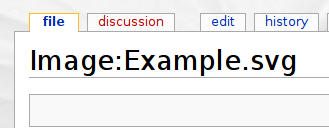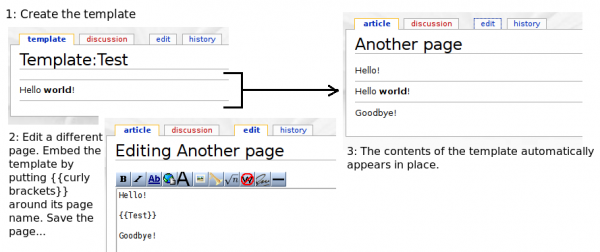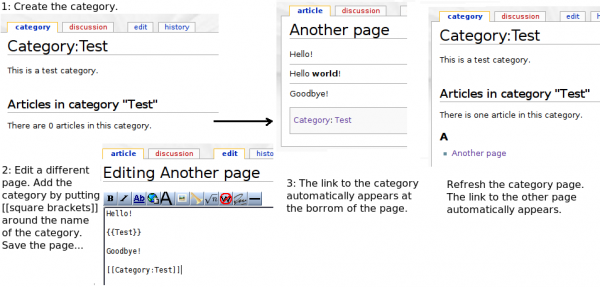Wikimedia Commons
About Wikipedia/MediaWiki.WikimediaFoundation software
What is a wiki?
It is useful to be able to distinguish between the tool used to create something and the thing itself. Just as you can use word processor software to create a text document, you can use wiki software to create a wiki. In this case the term wiki refers to the content created by the contributors.
What is Wikipedia/MediaWiki.WikimediaFoundation?
Wikipedia/MediaWiki.WikimediaFoundation ( http://www.mediawiki.org/ ) is the wiki software behind Wikipedia and Wikimedia Commons. It controls user accounts and permissions, converting "wiki markup" to HTML, storing all revisions of all articles, and much, much more.
Much of what you learn about contributing to Wikimedia Commons, therefore, will be applicable when you edit Wikipedia, or for that matter any other wiki website which uses the Wikipedia/MediaWiki.WikimediaFoundation wiki software underneath.
Structure in Wikimedia wikis
Wikipedia/MediaWiki.WikimediaFoundation provides several mechanisms for creating structure within the wiki. By default, there is no required structure -- but that tends to make the content very difficult to navigate. So sites using Wikipedia/MediaWiki.WikimediaFoundation often build their own structure.
Namespaces
Pages in Wikipedia/MediaWiki.WikimediaFoundation are divided into namespaces. By default, pages are created in the Main namespace, which is indicated by no prefix. All other namespaces have an explicit prefix, which is separated from the page name by a colon (:). The use of namespaces typically divides content up by purpose. Some namespaces also give pages special behaviour.

This screenshot of a page's title shows that the page is in the Image namespace and the page's name is "Example.svg".
In most wikis, where most work is done on text documents, the namespace that is most commonly used is the Main namespace. On Wikimedia Commons, the most commonly used namespace is the Image namespace. One Image page contains a link to one media file, and metadata about that file. (Despite the name, Image pages are used to represent all kinds of files that can be uploaded.)
The namespaces most commonly used to create structure are Template and Category.
Template
Templates (pages in the Template namespace) allow some "boilerplate text" to be placed on multiple pages - for example, license or author information. If that text needs to be changed (say, an author changes their contact details), then they can edit the template and that change will be automatically updated on all the pages where the template is being used. They can also be used in this way to ensure uniform presentation of some particular text.

These screenshots show the effect of embedding a template in a page.
In Wikimedia Commons, templates are used for a variety of purposes. One of the most important purposes is for indicating which licenses apply to which media files. Each image page should have at least one embedded license template (sometimes called "tags").
Category
Categories (pages in the Category namespace) can be used to automatically group pages. Rather than maintaining a list of media files that relate to a particular topic manually, categories automatically keep such lists up to date.

These screenshots show the effect of adding a category link to a page.
In Wikimedia Commons, categories are used to sort files by topic and license (although the license categories are automatically added by the license templates). It's very important to add at least one descriptive category to each Image page. These categories help make files "findable" and increase the ease of navigation around the site.
Wikimedia Commons as a central Wikimedia resource
Normally, images can only be inserted in a wiki page if they have already been uploaded to that wiki. However there is a special link between Wikimedia Commons and all the other Wikimedia projects, that allows images in Wikimedia Commons to be used in any of the Wikimedia projects as if the file was uploaded to that local wiki. This is very convenient: upload once, use everywhere.
Wiki markup cheat sheet
Wikipedia/MediaWiki.WikimediaFoundation doesn't come with a WYSIWYG (What you see is what you get) editor by default. Instead, it lets users to format their text by "wiki markup". Learning wiki markup can be daunting at first, especially table and template syntax, but the basics can be learnt fairly quickly.
If you are reading this documentation online, it is strongly recommended to experiment with the markup in an actual Wikipedia/MediaWiki.WikimediaFoundation wiki such as Wikipedia. For example, these two links are useful to have open together:
The "sandbox" is a special page designed especially for experimenting. Users new and old can feel free to practice and test their wiki markup skills by editing, saving or previewing and observing the changes.
Below is an introduction to the most commonly used elements of wiki markup.
| Description | You type | You get |
| applies anywhere | ||
| Italic text | ''italic'' | italic |
| Bold text | '''bold''' | bold |
|
Link to a wiki page |
Link to the [[Main Page]] Link to the [[Template:Test]]
|
Link to the Main Page
Link to the Template:Test
|
| Link to an external site
|
Link to [http://www.google.com/ Google]
|
Link to Google
|
| Embed a template | This is a {{test}} | (what appears depends on the contents at Template:Test) |
| Add a category | [[Category:Test]] | (an automatic link appears at the bottom of the page) |
| only at the beginning of the line | ||
| Indent text |
:Single indent
|
|
| Headings of
different levels |
==level 2==
|
Level 2
Level 3 Level 4 |
| Bullet list |
* one
|
|
| Numbered list |
# one
|
|